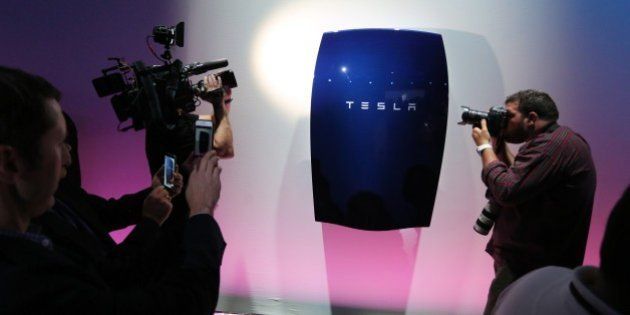
Tesla CEO and co-founder Elon Musk announced the company’s latest product, a battery system for homes and businesses with a suggested price of $3000-$3500.
Called Powerwall, it uses the company’s expertise in battery technology used in its electric cars, and aims to ‘fundamentally change the way the world uses energy”, according to the billionaire CEO Elon Musk.
We’ve compiled a list of quotes from leading business analysts in the clean and renewable energy sector to get a measure of the battery system called Powerwall.
1) The Specs
Weight: 100 kg
Technology: Wall Mounted Rechargeable Lithium Ion Battery
Energy: 7kWh or 10kWh
Continuous Power: 2kW, 3.3 kW peak
Peak Power: 3kW
Round Trip Efficiency: >92%
Operating Temperature Range: -20C (-4F) to 43C (110F)
Warranty: 10 years
Dimensions: H: 1300mm W: 860mm D:180mm
2) Like Every Elon Musk Venture, It’s A Risky Proposition
“There’s more risk than opportunity on the residential side. It’s not clear if there’s an opportunity at all. So, if that’s the basket in which they’re putting their eggs, there’s a tremendous amount of market risk. In the end, homeowners don’t want to be electric utilities.” Sam Jaffe, CEO, Cyngus Energy Storage is quoted by Fortune as saying .
2) The Tesla Gigafactory Will Be Manufacturing Them At Unprecedented Scale
“Tesla can bring it to a wider audience than most other people can,” said Shayle Kann, a vice president at GTM Research, which tracks clean-tech industries, is speaking in NY Times. “Once they get the Gigafactory up and going, they will be able to deploy on a scale that no one will quite be able to rival. So they may have a cost advantage in that.”
3) It’s A Potential Billion Dollar Industry
The annual market value for the power storage market $42 million in 2014 to more than $1 billion by 2018, says a report titled the ‘Future of Solar-Plus-Storage in the U.S’.
4) It Creates A Whole New Revenue Stream For Tesla
“We believe entering storage will allow (Tesla) to more rapidly grow the company while diversifying its revenue streams" said Ben Kallo of Baird Equity Research, speaking to USA Today.
5) There’s A Lot of Pent Up Domestic Demand
Bloomberg reports that an energy-storage mandate in California requires the power utilities to buy 1.3 gigawatts of energy storage capacity by 2020.
6) It Will Be Connected To The Internet
The battery will come with a 10 year guarantee and come with integrated management software. "It will be connected to the Internet so we can create smart micro-grids," Elon Musk is quoted as saying in Arstechnica.
7) Alternative Storage Technologies To Lithium Ion Batteries Could Get Crowded Out
Other battery technologies which have a longer lifecycle and better reliability could will have difficulty entering the market, says Dr. Varun Sivaram, clean energy physicist in a guest column in Forbes.



Contact HuffPost India